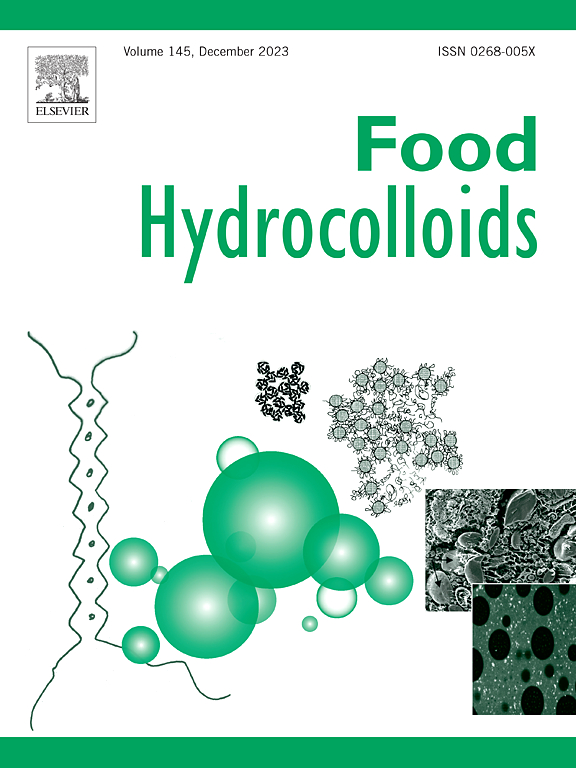IF 11
1区 农林科学
Q1 CHEMISTRY, APPLIED
引用次数: 0
摘要
本研究调查了不同大豆蛋白聚合体的形态差异和结构灵活性,并研究了它们在不同 pH 值下的界面和泡沫特性差异。研究结果表明,聚合体的形态存在很大差异,导致其柔韧性发生显著变化。大豆蛋白纤维(SPF)的分子柔韧性优于其他聚合体,在 pH 值为 9 时表现出最大柔韧性(A280 nm = 0.35)。 大豆蛋白分形聚合体(SPA)由于二硫键、α-螺旋和 β-片的含量增加,在所有 pH 值下都表现出刚性结构。与 SPI 相比,大豆蛋白纳米粒子(SPN)的粒径减小,不规则卷曲增加,因此分子柔韧性明显提高。此外,SPF-9 显示出最低的界面张力(39.29 mN/m)、最佳的溶解度(97.54 %)和发泡能力(180.00 %)。SPN-9 的泡沫稳定性最好。研究结果表明,聚合体的界面特性和发泡能力与其分子柔韧性呈正相关,聚合体形态和结构的改变会影响蛋白质的柔韧性,从而提高界面功能特性。这项研究成果为大豆蛋白在泡沫膳食中的应用奠定了理论基础。本文章由计算机程序翻译,如有差异,请以英文原文为准。

Exploring the interfacial behavior and foam characteristics of various soy protein aggregates: Insights of morphology and conformational flexibility
This study investigates the morphology differences and structural flexibility of different soy protein aggregates, and examines their disparities in interfacial and foam characteristics at across pH levels. The results indicated substantial variations in the morphology of the aggregates, resulting in a notable alteration in their flexibility. The soy protein fibrils (SPF) demonstrated superior molecular flexibility relative to the other aggregates, demonstrating maximum flexibility (A280 nm = 0.35) at pH 9. Soy protein fractal aggregates (SPA) exhibited a rigid structure at all pH levels because of the elevated presence of disulfide bonds, α-helixs, and β-sheets. The reduced particle size and elevated presence of irregular convolutions resulted in significantly greater molecular flexibility of the soy protein nanoparticles (SPN) in comparison to SPI. SPN exhibited the second highest flexibility following SPF, was distinguished by tiny particle size and homogenous dispersion, and demonstrated optimal flexibility at pH 9. Furthermore, SPF-9 displayed the lowest interfacial tension (39.29 mN/m), the best solubility (97.54 %), and the foaming ability (180.00 %). And SPN-9 demonstrated the best foam stability. It was ascertained that the interfacial properties and foaming ability of aggregates were positively correlated with their molecular flexibility and that alterations in the morphology and structure of aggregates could impact the flexibility of proteins and thereby enhance the interfacial functional properties. The outcomes of this study establish a theoretical foundation for the application of soy protein in foam-based meals.
求助全文
通过发布文献求助,成功后即可免费获取论文全文。
去求助
来源期刊

Food Hydrocolloids
工程技术-食品科技
CiteScore
19.90
自引率
14.00%
发文量
871
审稿时长
37 days
期刊介绍:
Food Hydrocolloids publishes original and innovative research focused on the characterization, functional properties, and applications of hydrocolloid materials used in food products. These hydrocolloids, defined as polysaccharides and proteins of commercial importance, are added to control aspects such as texture, stability, rheology, and sensory properties. The research's primary emphasis should be on the hydrocolloids themselves, with thorough descriptions of their source, nature, and physicochemical characteristics. Manuscripts are expected to clearly outline specific aims and objectives, include a fundamental discussion of research findings at the molecular level, and address the significance of the results. Studies on hydrocolloids in complex formulations should concentrate on their overall properties and mechanisms of action, while simple formulation development studies may not be considered for publication.
The main areas of interest are:
-Chemical and physicochemical characterisation
Thermal properties including glass transitions and conformational changes-
Rheological properties including viscosity, viscoelastic properties and gelation behaviour-
The influence on organoleptic properties-
Interfacial properties including stabilisation of dispersions, emulsions and foams-
Film forming properties with application to edible films and active packaging-
Encapsulation and controlled release of active compounds-
The influence on health including their role as dietary fibre-
Manipulation of hydrocolloid structure and functionality through chemical, biochemical and physical processes-
New hydrocolloids and hydrocolloid sources of commercial potential.
The Journal also publishes Review articles that provide an overview of the latest developments in topics of specific interest to researchers in this field of activity.
 求助内容:
求助内容: 应助结果提醒方式:
应助结果提醒方式:


